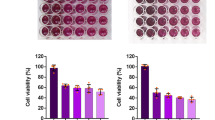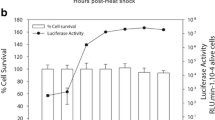Abstract
Heat shock protein (HSP) synthesis results from various types of injury, including heat shock (HS) and some oxidants. The intracellular signals leading to HSP synthesis are not yet fully elucidated. We have studied the influence ofNNN’N’-tetrakis(2-pyridylmethyl)ethylene diamine (TPEN), a metal chelator known to induce cellular zinc and copper deprivation, on resistance to heat and on hsp70 synthesis in HaCaT keratinocytes. TPEN was shown to sensitize HaCaT cells to heat shock. The effect of TPEN was neutralized by equimolar Zn2+. By the use of sodium dodecyl sulfate-polyacrylamide gel electrophoresis analysis and Western blotting characterization of hsp70, it was shown that cultured HaCaT cells constitutively express the inducible form of hsp70. The application of TPEN alone slightly increases the level of hsp70 but inhibits its induction by HS. This inhibitory effect is related to metal deprivation, because it is eliminated when Cu2+ or Zn2+ ions are supplied together with TPEN. These results suggest that these metals are involved in the expression by keratinocytes of a stress protein which has a protective action against environmental stress.
Similar content being viewed by others
References
E. V. Maytin, Heat shock proteins and molecular chaperones: implications for adaptative responses in the skin,J. Invest. Dermatol. 104, 448–455 (1995).
B. S. Polla, S. Kantengwa, D. François, S. Salvioli, C. Franceschi, C. Marsac, et al., Mitochondria are selective targets for the protective effects of heat shock against oxidative injury,Proc. Natl. Acad. Sci. USA 93, 6458–6463 (1996).
F. Trautinger, I. Kindas-Mugge, B. Barlan, P. Neuner, and R. M. Knobler, 72-kD heat shock protein is a mediator of resistance to ultraviolet B light,J. Invest. Dermatol 105, 160–162 (1995).
J. Anathan, A. Goldberg, and R. Voellmy, Abnormal proteins serve as eukaryotic stress signals and trigger the activation of heat shock genes,Science 232, 522–524 (1986).
P. K. Sorger, Heat shock factor and the heat shock response,Cell 65, 363–366 (1991).
P. D. Zalewski, I. J. Forbes, and W. H. Betts, Correlation of apoptosis with change in intracellular labile Zn(II) using Zinquin [(2-methyl-8-p-toluenesulphonamido-6-quinolyloxy)acetic acid], a new specific fluorescent probe for Zn(II),Biochem. J. 296, 403–108 (1993).
M. O. Parat, M. J. Richard, J. C. Béani, and A. Favier, Involvement of zinc in intracellular oxidant / antioxidant balance,Biol. Trace Element Res. 60, 187–204 (1997).
T. Hatayama, Y. Asai, T. Wakatsuki, T. Kitamura, and H. Imahara, Regulation of HSP70 synthesis induced by cupric sulfate and zinc sulfate in thermotolerant HeLa cells,J. Biochem. 114, 592–597 (1993).
T. Hatayama, Y. Tsukimi, T. Wakatsuki, T. Kitamura, and H. Imahara, Characteristic induction of 70 000 Da heat shock protein and metallothionein by zinc in HeLa cells,Mol. Cell. Biochem. 112, 143–153 (1992).
M. Zafarullah, S. Su, and L. Gedamu, Basal and inducible expression of metallothionein and heat shock protein 70 genes in bovine articular chondrocytes,Exp. Cell Res. 208, 371–377 (1993).
R. A. Swanson and F. R. Sharp, Zinc toxicity and induction of the 72 kD Heat Shock Protein in primary astrocyte culture,Glia 6, 198–205 (1992).
J. B. Mitchell, A. Russo, T. K. Kinsella, and E. Glatstein, Glutathione elevation during thermotolerance induction and thermosensitization by glutathione depletion,Cancer Res. 43, 987–991 (1983).
K. Rokutan, T. Hirakawa, S. Teshima, S. Honda, and K. Kishi, Glutathione depletion impairs transcriptional activation of heat shock genes in primary cultures of guinea pig gastric mucosal cells,J. Clin. Invest. 97, 2242–2250 (1996).
P. Boukamp, R. Petrussevka, D. Breitkreutz, J. Hornung, A. Markham, and N. Fusenig, Normal keratinization in a spontaneously immortalized aneuploid human keratinocyte cell line,J. Cell Biol. 106, 761–771 (1988).
B. S. Polla, A. M. Healy, W. C. Wojno, and S. M. Krane, Hormone 1 alpha,25-dihydroxyvitamin D3 modulates heat shock response in monocytes,Am. J. Physiol. 252, 640–649 (1987).
T. Mosman, Rapid colorimetric assay for cellular growth and survival: application to proliferation and cytotoxicity assays,J. Immunol Methods 65, 55–63 (1983).
O. H. Lowry, N. J. Rosebrough, A. L. Farr, and R. J. Randall, Protein measurement with Folin phenol reagent,J. Biol. Chem. 193, 265–275 (1951).
U. K. Laemli, Cleavage of structural proteins during the assembly of the head of bacteriophage T4,Nature 227, 680–685 (1970).
F. Trautinger, I. Trautinger, I. Kindas-Mügge, D. Metze, and T. A. Luger, Human keratinocytes in vivo and in vitro constitutively express the 72-kD heat shock protein,J. Invest. Dermatol. 101, 334–338 (1993).
T. Abe, T. Konishi, T. Katoh, H. Hirano, K. Matsukuma, M. Kashimura, et al., Induction of heat shock 70 mRNA by cadmium is mediated by glutathione suppressive and non-suppressive triggers,Biochim. Biophys. Acta 1201, 29–36 (1994).
A. C. Walsh, S. G. Michaud, J. A. Malossi, and D. A. Lawrence, Glutathione depletion in human lymphocytes: analysis of activation-associated gene expression and the stress response,Toxicol. Appl. Pharmacol. 133, 249–261 (1995).
H. Liu, R. Lightfoot, and J. L. Stevens, Activation of heat shock factor by alkylating agents is triggered by glutathione depletion and oxidation of protein thiols,J. Biol. Chem. 271, 4805–4812 (1996).
M. J. McCabe Jr., S. A. Jiang, and S. Orrenius, Chelation of intracellular zinc triggers apoptosis in mature thymocytes,Lab. Invest. 69, 101–110 (1993).
M. O. Parat, M. J. Richard, S. Pollet, C. Hadjur, A. Favier, and J. C. Beani, Zinc and DNA fragmentation in keratinocyte apoptosis: its inhibitory effect in UVB-irradiated cells,J. Photochem. Photobiol. B—Biol. 37, 101–106 (1997).
I. Filippovich, N. Sorokina, K. K. Khana, and M. F. Lavin, Butyrate induced apoptosis in lymphoid cells preceded by transient overexpression of HSP70 mRNA,Biochem. Biophys. Res. Commun. 198, 257–265 (1994).
D. D. Mosser and L. H. Martin, Induced thermotolerance to apoptosis in a human T lymphocyte cell line,J. Cell Physiol. 151, 561–570 (1992).
K. S. Kane and E. V. Maytin, Ultraviolet B-induced apoptosis of keratinocytes in murine skin is reduced by mild local hyperthermia,J. Invest. Dermatol. 104, 62–67 (1995).
D. D. Mosser, A. W. Caron, L. Bourget, C. Denis Larose, and B. Massie, Role of the human heat shock protein hsp70 in protection against stress-induced apoptosis,Mol. Cell. Biol. 17, 5317–5327 (1997).
C. Harris, M. R. Juchau, and P. E. Mirkes, Role of glutathione and HSP70 in the acquisition of thermotolerance in postimplantation rat embryos,Teratology 43, 229–239 (1991).
L. E. Huang, H. Zhang, S. W. Bae, and A. Y. Liu, Thiol reducing reagents inhibit the heat shock response,J. Biol. Chem. 269, 30,718–30,725 (1994).
M. Jacquier-Sarlin and B. S. Polla, Dual regulation of heat-shock transcription factor (HSF) activation and DNA-binding activity by H2O2: role of thioredoxin,Biochem. J. 318, 187–193 (1996).
Author information
Authors and Affiliations
Rights and permissions
About this article
Cite this article
Parat, MO., Richard, MJ., Favier, A. et al. Metal chelatorNNN’ N’-tetrakis-(2-pyridylmethyl)ethylene diamine inhibits the induction of heat shock protein 70 synthesis by heat in cultured keratinocytes. Biol Trace Elem Res 65, 261–270 (1998). https://doi.org/10.1007/BF02789101
Received:
Revised:
Accepted:
Issue Date:
DOI: https://doi.org/10.1007/BF02789101




